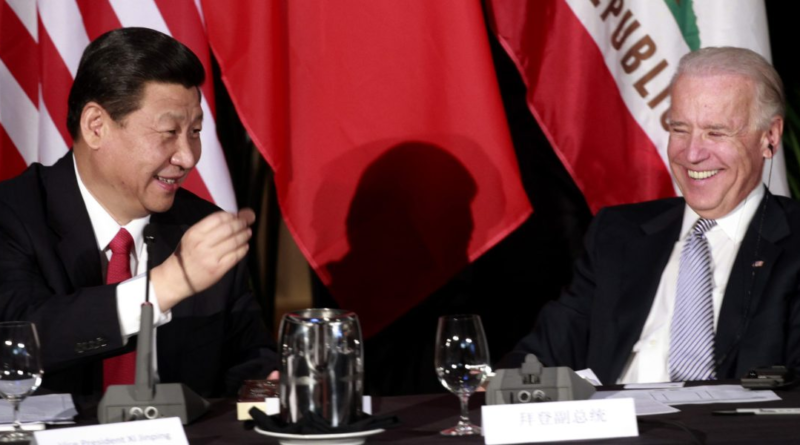America and China’s $574 billion chip war has already scored an ‘extraordinary success beyond anyone’s wild dreams’ for Joe Biden
Last October was the starting gun in a whole new race between the U.S. and China, and this summer marked a midway point of sorts. From the vantage point of Kevin Klyman, a technology policy researcher at Harvard University, “it has gone quite well for the Biden administration in terms of getting foreign partners on board.”
He was talking, of course, about semiconductor chips, the magical tiny structures that power everything from computers to computerized cars and are becoming something like the oil of the 21st century.
President Joe Biden set the clock racing on Oct. 7 with a set of export controls that sought to restrict China’s procurement of highly advanced chips and the computers containing them. Also, they didn’t just target the cutting-edge chips but the tools that could be used to make them, such as Netherlands-based ASML’s state-of-the-art lithography machine. That’s a serious barrier preventing China from developing its own models of the most advanced chips. And America’s Dutch and Japanese allies have come on board, stunning experts like Klyman.
“It has been an extraordinary success beyond anyone’s wildest dreams that the Netherlands and Japan have joined U.S. export controls to the hilt.” Klyman told Fortune. “That was not what outside analysts expected.”
This past August, Biden signed a new executive order, banning U.S. investments in three critical Chinese technology sectors: semiconductors, quantum tech, and AI. The ban, which takes effect next year, is sure to accelerate private equity and venture capital funds’ already rapid divestment from the nation. Weeks later, Biden dispatched Commerce Secretary Gina Raimondo to Beijing. While it was the latest in a series of visits meant to thaw the relationship between the two superpowers, and Raimondo was at pains to say the U.S. is not pursuing an economic “decoupling” from the second-largest economy in the world, inevitably the conversation turned to chips. Raimondo told reporters that her counterpart, Chinese Commerce Minister Wang Wentao, and other officials had asked for the U.S. s “to reduce export controls on technology,” and that “Of course, I said no. We don’t negotiate on matters of national security.”
With China’s $18 trillion economy battling a severe bout of indigestion and threatening to export its deflation to western economies that have been struggling with high inflation, instead, Klyman and other experts see the chip wars casting a long shadow. “The impacts that we see are not narrowly tailored to advanced semiconductors,” Klyman said. “We see it affecting China’s technology sector writ large.”
Battle lines drawn
The battle for semiconductor supremacy has been a hot topic throughout the nascent 2020s, as the crippled supply chains of the pandemic emphasized chips’ importance for every aspect of modern life. When chip production ground to a halt, every American seeking to buy a car suddenly turned to the used auto market, which soared to historic levels.
Chris Miller wrote the definitive book on the subject, the fittingly titled Chip War, winner of the Financial Times’ business book of the year for 2022 and Fortune 500 CEOs’ most widely read book this past summer. The professor of International History at Tufts University told Fortune that the Biden administration has indeed scored a coup, as, aside from the U.S. and China, Japan and the Netherlands are the two most important countries for machine tools used to create chips.
Skirting these controls would be very difficult for China, according to Miller, so he generally agreed that the White House’s actions should effectively challenge China’s goal of building its own cutting-edge chip industry.
Klyman put the scale of the actions in perspective. “The U.S. has determined that semiconductors are essential for China’s military modernization, and so has done its best to undermine China’s semiconductor industry by taking a really unprecedented step and launching a surgical strike on that industry,” he told Fortune.
What’s a chip for?
With semiconductor chips being the lifeblood of almost all modern technology, from microwaves to cars to fighter jets, they are also big business. The industry notched an all-time high of $574 billion in sales in 2022, according to the Semiconductor Industry Association, and the revenue trends show them shifting from computers to, well, everything else.
But the U.S. is most concerned when it comes to chips for weapons that have not yet been invented. In justifying export controls, the Bureau of Industry and Security noted that semiconductors are necessary to train AI systems, which China could then use to violate human rights, surveil people, and go to war with the U.S. (For reference, OpenAI’s ChatGPT was trained on 10,000 Nvidia chips.)
A.I. could be used to create autonomous weapons or to supplement military power through innovations that are not necessarily arms-related, Jeffrey Ding, a professor of political science at George Washington University, said. But while controls have strong military justification, Ding said, in the present, their effect is more basic: To maintain the U.S.’ position as the world’s largest economy.
Ding compares A.I. to electricity, a technology that’s so widely applicable it can shift entire economies and the global balance of power.
“Historically, general-purpose technologies like AI, or electricity, have inspired waves of productivity growth, where one country can sustain economic growth at higher levels than another country and become the leading economic power,” Ding said. “We’ve seen that with past industrial revolutions, like the First Industrial Revolution and Britain’s rise, and the Second Industrial Revolution and the U.S.’s rise.”
Having maintained its position through the Third Industrial Revolution, which was based on electricity, the U.S. is now in what some are calling the Fourth Industrial Revolution, powered by AI. and interconnectivity. Some experts are hopeful that strategic export controls will hold U.S. technological primacy through this era by kneecapping China’s chip and AI sectors before they take off.
For now, it’s highly unlikely that China can create its own versions of the advanced machinery it needs to produce cutting-edge chips, said Scott Young, a geotechnology analyst at Eurasia Group, said. He described ASML’s state-of-the-art lithography machines, which etch the patterns onto microscopic chips, as “so sophisticated that it makes reverse engineering them almost impossible,” adding that they may be the most advanced machines ever invented.
The limitations of controls
But while export controls will work in the short term, in the long term, Young thinks they’re a “case of diminishing returns,” predicting their efficacy will decline as China finds ways to circumvent regulations.
Similarly, Ding says that enforcement problems limit the overall impact of export controls. The problems include smuggling prohibited items through loosely monitored countries, or selling highly advanced chips disguised as lower-end chips, and Chinese AI labs’ use of cloud computing to access advanced chip clusters located in other countries.
Instead of trying to limit access to tech abroad, Ding thinks the U.S. should consider funding education domestically as a policy tool.
“We could do so much more good for the national security interest if we took all the time, all the political capital, all the space that has been consumed by discussions over export controls, and moved that to thinking about how to build the infrastructure for training a broad pool of A.I. engineering talent,” he said.
According to Ding,, expediting the training of AI engineering students could be one of the most important policy levers in the U.S.-China tech competition, a similar role that educational institutions played in the last century, when they established new disciplines like electrical or mechanical engineering.
Export controls work counter to this policy since they can make foreign scientists feel less welcome in the U.S., creating a worse overall environment for cultivating talent, Klyman of Harvard added. And by forcing China to be less dependent on the U.S., they encourage the country to develop its own self-sustaining semiconductor ecosystem, essentially shifting the tech war from exports to education. While that’s many years away, he said, the lag may not be as large as the U.S. would hope.
Klyman echoed Ding’s call for a focus on education in the tech war, saying that cultivating a genius capable of breakthroughs—an Albert Einstein or a Robert Oppenheimer—could increase the capability of the U.S. technological system “tenfold.”
“The returns to education are almost endless,” Klyman said. “The U.S. is already a leader in having A.I. scientists, but the rate of growth is not as high as in other countries, and the U.S. does not keep its scientists as well as it once did. So immigration reform plus education would be the key.”
He added, “People are the secret sauce that make this technology work.”


